Acer platanoides
 |
 |
 |
|
Norway Maple |
Leaf of Norway Maple |
Bark of Norway Maple |
Summary
Foliage: Deciduous broadleaf
Height: 40 to 50 feet
Spread: May be equal to its height
Shape: Spreading
Summer foliage is dark green and turns yellow in the fall.
Plant Needs
Zone: 3 to 7
Light: Partial shade to full sun
Moisture: Wet, moist, or dry
Soil Type: Sandy, loam, or clay
pH Range: 3.7 to 7.0
Functions
Suggested uses for this plant include shade, specimen plant, and street tree.
Planting Notes
Transplants readily. Adapts well to wide range of soil conditions, including clay soils. Tolerates air pollution. Salt tolerant. Tolerates hot, dry conditions better than Sugar Maple.
Care
Prune diseased or storm-damaged wood as needed. Because of this tree's dense foliage and shallow root system, mulching around the base of the tree is suggested since it is hard to get anything to grow under it.
See Soil Improvement
Problems
Susceptible to Verticillium wilt, anthracnose, and some leaf scorch.
Alternatives
Consult local sources, including historic or public gardens and arboreta, regarding cultivars and related species that grow well in your area.
Cultivars of ACER PLATANOIDES
`Crimson King' has purple leaves that retain their color all summer.
`Columnare' is one of several varieties with a narrow, columnar habit of growth.
`Globosum' is a low growing, round-headed tree that can be used under utility wires.
Comments
Native to Europe, but has been widely planted throughout the eastern United States. More upright and smaller cultivars are better choices as street and lawn trees.
This material was developed by Carol Ness as part of the Interactive Design and Development Project funded by the Kellogg Foundation. Mary Miller, Project Director. Diane Relf, Content Specialist, Horticulture. Copyright 1989 by VCE.

